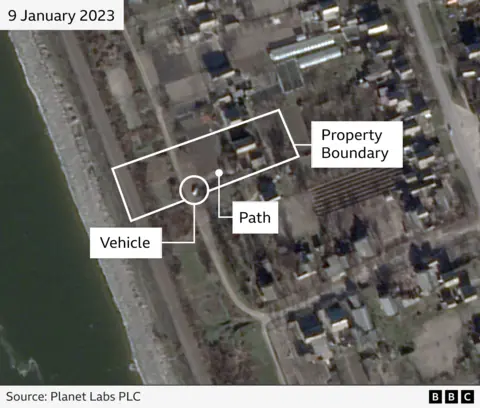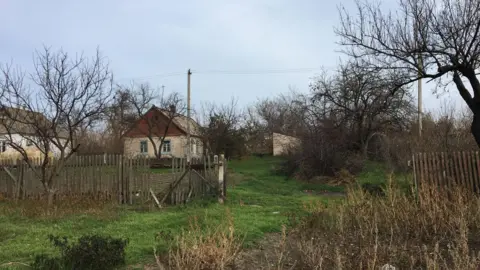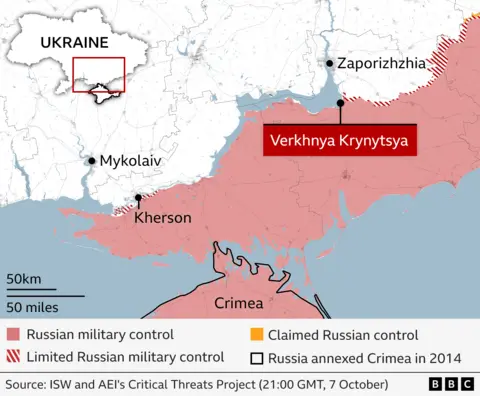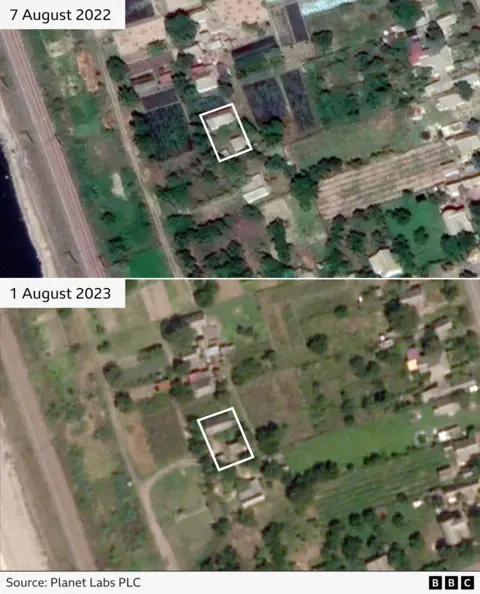Vitaly ShevchenkoRussia Editor, BBC Monitoring
 BBC
BBCIt’s been another busy day at work.
Russian forces have attacked the Zaporizhzhya region again: a region in southern Ukraine, divided between the Russian invaders, who claim it all as their own, and the defending Ukrainians.
Sitting in my office in central London, I was feeling nostalgic. I decided to take a quick look at the latest satellite images of my childhood village – the poetically titled village of Verkhnya Krynitsia (or Upper Spring in English), in the Russian-occupied part of the region, just a few kilometers from the front lines.
I could see the familiar dirt paths, the houses drowning in lush vegetation. But something caught my attention.
Amidst all the apparent tranquility of a small village I remember well, a new feature emerged: a well-used road. It led straight to my childhood home.
Satellite images show a track that first appeared in the summer of 2022, four months after the start of the occupation. Pictures from the winter showed it appearing again and a car making use of it in January 2023.
I can think of only one group of people who could use the road in an occupied village so close to the front line: Russian soldiers. They just have a reason to be in a war zone.
Verchnia krynitsia
The truth is, my childhood village isn’t quiet anymore. Russia occupied Verkhnya Krynitsia shortly after the start of the full-scale invasion in February 2022.
By that point, my old house was probably vacant. My family had sold it long ago, but I visited Verkhnia Krynitsia at least once a year before it was occupied, and saw the house seemingly abandoned, its garden overgrown.
 Vitaly Shevchenko/BBC
Vitaly Shevchenko/BBCIt was no surprise: the village was small and quiet at the best of times, and for anyone still under retirement age, looking for work meant moving elsewhere.
But many stayed, and more than a thousand people were still there when Russia launched its invasion. Two days later, Ukrainian authorities delivered 43 Kalashnikov rifles to help villagers fight the Russians.
At a community gathering, residents decided not to use them against the invaders. A month later, the Russians arrested the village head, Serhiy Yavorsky, beat him and tortured him with electricity, needles and acid, according to testimony presented in a Ukrainian court.
The Russians also targeted a sewage treatment plant outside the village and set up a command post there once the Ukrainians abandoned the facility.

Even the village surroundings have changed beyond repair.
Before the large-scale Russian invasion, Verkhnya Krynitsia was located on the beautiful Kakhovka reservoir, which was so vast that we used to call it “the sea.”
You can see it from almost anywhere in the village. It’s where locals went to swim in the summer, and where visitors from all over the area come in the winter to go ice fishing. One of my earliest memories is of local women singing Ukrainian folk songs as the sun was setting in Kakhovka on a warm summer evening.
The sea disappeared after the Kakhovka Dam was destroyed in June 2023, leading to devastating floods that destroyed homes and farmland.
To find out what conditions now prevail in Verkhnia Krynitsia, I tried to communicate with local residents.
As expected, getting answers was very difficult.
Many have left, and those still in the village – as in other occupied parts of Ukraine – are afraid to talk to the media. Front-line positions in particular are lawless places, where retaliation by Russian forces can be swift and brutal.
Social media groups around Verkhnia Krynitsia fell silent after its occupation, leaving the questions she posted there unanswered.
Asking someone to go and look at my house is out of the question. What was once a quiet and calm village has turned into a zone of fear.
The danger in Verkhnia Krynitsia also comes from the sky. The village’s proximity to the front line means it is a dangerous location and vulnerable to frequent air attacks from the Ukrainians.
An acquaintance of mine told me that locals prefer to stay indoors for fear of being hit by drones. “It’s very dangerous there,” I was told. “They are active, and they can target you, your house, or your car. Our village has changed a lot, Vitaly.”
New residents
So, given the danger and devastation the war had caused to Verkhnya Krynitsia, who could have marked the path leading to and from my old house?
It is very unlikely that anyone except Russian soldiers would choose to move to the village now.
Many of them moved into vacant houses after the seizure of Verkhnia Krynitsia. In June 2022, authorities in Zaporizhia said they had information that Russian forces were staying in the village. This was when satellite images first showed track marks at my old house.
To check whether I was right in assuming that Russian soldiers had most likely moved to my old house, I contacted the Ukrainian 128th Separate Heavy Mechanized Brigade, which is involved in operations in the region.
Her spokesman Oleksandr Kurbatov told me: “You are not wrong. It is very likely.”
He added that as local residents flee frontline areas, they are being replaced by the Russian army.
“If there are not enough empty houses, the demand goes up,” he told me. “Of course, there are usually military personnel from the occupation army.”
Because no one in the village was willing to risk a look at my house, I asked my BBC Verification colleague, Richard Irvine-Brown, to obtain and analyze recent satellite images. They showed a pattern of movement throughout the house I grew up in.
There was no sign of a road to the property in March 2022, a month after the invasion.
Aside from a faint trail seen in two satellite images in June, the property appeared to have been overlooked. The track then reappeared in December, and a car was seen using it in January 2023. We don’t have any photos of the property again until August, when the track became well established.

The path fades and reappears with the seasons, showing that whoever uses it does so only periodically.
The property appears to be used during the winter, likely by Russian soldiers, who were moving into vacant properties. This is reasonable, because Ukraine’s harsh winters could make it too cold for men or their supplies to survive in trenches, temporary housing, and storehouses.
The truth about what happened to my home may not be known for a long time, and certainly not while the village is under occupation.
For now, my old home seems to have become a small cog in the broader machine of Russia’s war in Ukraine.
Additional reporting by Richard Irvin Brown
https://ichef.bbci.co.uk/news/1024/branded_news/7db4/live/f7874bf0-a430-11f0-928c-71dbb8619e94.png
Source link
